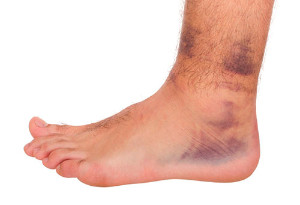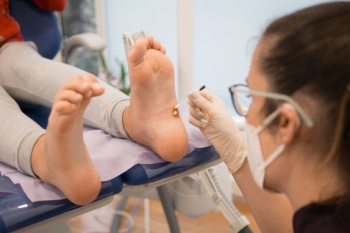
Diabetic foot ulcers pose a significant challenge in managing diabetes, often leading to severe complications if left untreated. Among the array of treatment options, surgical offloading procedures stand as a critical intervention. These procedures involve relieving pressure from the affected area, allowing the ulcer to heal effectively. Surgeons may opt for techniques, such as tendon lengthening and bone resection. By redistributing weight-bearing forces, these surgeries alleviate stress on the ulcer, promoting tissue repair and reducing the risk of infection. While surgical intervention may seem daunting, it offers a vital opportunity for individuals with diabetic foot ulcers to regain mobility and prevent further deterioration. Additionally, when coupled with comprehensive diabetic foot care, including proper wound management and glycemic control, these procedures enhance the prospects of successful ulcer healing and minimize the likelihood of recurrence. If you have diabetes and have developed a foot wound, it is strongly suggested that you consult a podiatrist who can help you determine if this type of foot surgery is right for you.
Foot surgery is sometimes necessary to treat a foot ailment. To learn more, contact Bruce Smit, DPM of Frankfort Foot & Ankle Clinic. Our doctor will assist you with all of your foot and ankle needs.
When Is Surgery Necessary?
Foot and ankle surgery is generally reserved for cases in which less invasive, conservative procedures have failed to alleviate the problem. Some of the cases in which surgery may be necessary include:
What Types of Surgery Are There?
The type of surgery you receive will depend on the nature of the problem you have. Some of the possible surgeries include:
Benefits of Surgery
Although surgery is usually a last resort, it can provide more complete pain relief compared to non-surgical methods and may allow you to finally resume full activity.
Surgical techniques have also become increasingly sophisticated. Techniques like endoscopic surgery allow for smaller incisions and faster recovery times.
If you have any questions please feel free to contact our office located in Frankfort, IL . We offer the newest diagnostic and treatment technologies for all your foot and ankle needs.

The arch of the foot is essential for supporting weight and movement, but high arches can lead to various issues. Identifying high arches can be done through methods like the wet footprint test or medical evaluation by a podiatrist. Problems associated with high arches include plantar fasciitis, metatarsalgia, claw toes, and hammer toe. Foot and ankle instability, often stemming from altered walking patterns and increased pressure, may also be the result of high arches. Custom orthotic devices, and wearing specialized shoes can offer relief. In severe cases, surgical intervention may be needed to enhance foot stability. A podiatrist can conduct a thorough examination and determine the appropriate treatment options. To correct foot problems brought on by high arches, it is suggested that you schedule an appointment with a podiatrist.
If you have any concerns about your feet, contact Bruce Smit, DPM from Frankfort Foot & Ankle Clinic. Our doctor can provide the care you need to keep you pain-free and on your feet.
Biomechanics in Podiatry
Podiatric biomechanics is a particular sector of specialty podiatry with licensed practitioners who are trained to diagnose and treat conditions affecting the foot, ankle and lower leg. Biomechanics deals with the forces that act against the body, causing an interference with the biological structures. It focuses on the movement of the ankle, the foot and the forces that interact with them.
A History of Biomechanics
Modern technological improvements are based on past theories and therapeutic processes that provide a better understanding of podiatric concepts for biomechanics. Computers can provide accurate information about the forces and patterns of the feet and lower legs.
Understanding biomechanics of the feet can help improve and eliminate pain, stopping further stress to the foot.
If you have any questions please feel free to contact our office located in Frankfort, IL . We offer the newest diagnostic and treatment technologies for all your foot and ankle needs.

Despite its association with strength, the Achilles tendon is susceptible to injury which can lead to discomfort and impair mobility. Several factors contribute to the development of Achilles tendonitis, including wearing improper footwear, overexertion during activities like speed or mountain running, and insufficient recovery time between training sessions. Other causes can include incorrect loading of weight on the legs or feet, poor running technique, and a lack of proper warm-up exercises. These factors collectively strain this strong tendon, leading to micro-tears in its structure. If left untreated, Achilles tendonitis can progress through various stages of severity. Initially, Achilles tendonitis may cause discomfort during activity or mild pain, which diminishes with rest and conservative measures. However, as the condition progresses, symptoms worsen, with visible changes in the tendon's structure and increased pain levels. Scar tissue formation and a loss of full functionality characterize the advanced stage of this injury. If you are experiencing Achilles tendon pain, it is suggested that you schedule an appointment with a podiatrist for an exam, diagnosis, and treatment options.
Achilles tendon injuries need immediate attention to avoid future complications. If you have any concerns, contact Bruce Smit, DPM of Frankfort Foot & Ankle Clinic. Our doctor can provide the care you need to keep you pain-free and on your feet.
What Is the Achilles Tendon?
The Achilles tendon is a tendon that connects the lower leg muscles and calf to the heel of the foot. It is the strongest tendon in the human body and is essential for making movement possible. Because this tendon is such an integral part of the body, any injuries to it can create immense difficulties and should immediately be presented to a doctor.
What Are the Symptoms of an Achilles Tendon Injury?
There are various types of injuries that can affect the Achilles tendon. The two most common injuries are Achilles tendinitis and ruptures of the tendon.
Achilles Tendinitis Symptoms
Rupture Symptoms
Treatment and Prevention
Achilles tendon injuries are diagnosed by a thorough physical evaluation, which can include an MRI. Treatment involves rest, physical therapy, and in some cases, surgery. However, various preventative measures can be taken to avoid these injuries, such as:
If you have any questions please feel free to contact our office located in Frankfort, IL . We offer the newest diagnostic tools and technology to treat your foot and ankle needs.

Deciphering between an ankle sprain and a strain is sometimes difficult, as both injuries share common symptoms but necessitate distinct treatment approaches. An ankle sprain occurs when ligaments, resilient bands of tissue that connect bones, endure excessive stretching or tearing. Strains are the result of damage to the muscles or tendons that surround the ankle joint. Fractures typically induce excruciating pain, rendering weight-bearing nearly impossible, while sprains often permit limited mobility despite discomfort. Furthermore, the site of discomfort varies. Fractures elicit localized pain and potential deformity, while sprains cause more diffuse discomfort. Swelling and unusual sensations such as numbness or tingling are more prevalent in fractures, indicating the urgency of proper diagnosis. Consulting a podiatrist for thorough assessment via imaging techniques like X-rays or bone scans is paramount to formulate tailored treatment strategies promptly. Whether you have an ankle sprain, strain, or fracture, timely intervention is critical to avoid long-term complications. In case of any type of ankle injury, it is suggested that you schedule an appointment with a podiatrist for a diagnosis and treatment options.
Ankle pain can be caused by a number of problems and may be potentially serious. If you have ankle pain, consult with Bruce Smit, DPM from Frankfort Foot & Ankle Clinic. Our doctor will assess your condition and provide you with quality foot and ankle treatment.
Ankle pain is any condition that causes pain in the ankle. Due to the fact that the ankle consists of tendons, muscles, bones, and ligaments, ankle pain can come from a number of different conditions.
Causes
The most common causes of ankle pain include:
Symptoms
Symptoms of ankle injury vary based upon the condition. Pain may include general pain and discomfort, swelling, aching, redness, bruising, burning or stabbing sensations, and/or loss of sensation.
Diagnosis
Due to the wide variety of potential causes of ankle pain, podiatrists will utilize a number of different methods to properly diagnose ankle pain. This can include asking for personal and family medical histories and of any recent injuries. Further diagnosis may include sensation tests, a physical examination, and potentially x-rays or other imaging tests.
Treatment
Just as the range of causes varies widely, so do treatments. Some more common treatments are rest, ice packs, keeping pressure off the foot, orthotics and braces, medication for inflammation and pain, and surgery.
If you have any questions, please feel free to contact our office located in Frankfort, IL . We offer the newest diagnostic and treatment technologies for all your foot care needs.

Understanding the causes of foot pain in children is essential for parents. Common factors that may affect your child’s feet include wearing ill-fitting shoes without proper cushioning, which can lead to pain over time. Conditions like Achilles tendonitis, often observed in active children, result from repetitive strain on the Achilles tendon and can lead to swelling and pain. Fractures and injuries can cause acute pain and contribute to the development of bunions. Bursitis and corns or calluses, often caused by wearing poorly fitting shoes, can result in inflammation and thickened skin. Structural issues, such as flat feet, or postural defects may also contribute to childhood foot discomfort. Inflammatory conditions like juvenile arthritis can cause persistent foot pain. For appropriate treatment to address your child's foot pain, it is suggested that you schedule an appointment with a podiatrist who can conduct a full exam and offer an accurate diagnosis and effective treatment plan.
The health of a child’s feet is vital to their overall well-being. If you have any questions regarding foot health, contact Bruce Smit, DPM of Frankfort Foot & Ankle Clinic. Our doctor can provide the care you need to keep you pain-free and on your feet.
Tips for Keeping Children's Feet Healthy
If you have any questions, please feel free to contact our office located in Frankfort, IL . We offer the newest diagnostic and treatment technologies for all your foot care needs.

Plantar warts, also known as verrucas, can be painful and disruptive. These growths, caused by the human papillomavirus, or HPV, often appear as rough, grainy lesions on the weight-bearing areas of the foot, such as the ball and heel. Plantar warts develop when HPV infects the outer layer of skin on the foot, typically through cuts, cracks, or breaks in the skin. Certain factors, such as a weakened immune system or previous bouts of plantar warts, can increase susceptibility. Treatment options include prescription strength medications containing salicylic acid, cryotherapy, laser treatments, or surgical removal. Because it can be difficult to eradicate plantar warts on your own, a podiatrist can provide tailored treatment options to alleviate discomfort and minimize the risk of recurrence. If you have plantar warts, it is suggested that you schedule an appointment with a podiatrist for an exam and treatment options.
Plantar warts can be very uncomfortable. If you need your feet checked, contact Bruce Smit, DPM from Frankfort Foot & Ankle Clinic. Our doctor will assist you with all of your foot and ankle needs.
About Plantar Warts
Plantar warts are the result of HPV, or human papillomavirus, getting into open wounds on the feet. They are mostly found on the heels or balls of the feet.
While plantar warts are generally harmless, those experiencing excessive pain or those suffering from diabetes or a compromised immune system require immediate medical care. Plantar warts are easily diagnosed, usually through scraping off a bit of rough skin or by getting a biopsy.
Symptoms
Treatment
To help prevent developing plantar warts, avoid walking barefoot over abrasive surfaces that can cause cuts or wounds for HPV to get into. Avoiding direct contact with other warts, as well as not picking or rubbing existing warts, can help prevent the further spread of plantar warts. However, if you think you have developed plantar warts, speak to your podiatrist. He or she can diagnose the warts on your feet and recommend the appropriate treatment options.
If you have any questions please feel free to contact our office located in Frankfort, IL . We offer the newest diagnostic and treatment technologies for all your foot and ankle needs.

Preventing foot and ankle running injuries involves a varied approach encompassing various aspects of training and recovery. Strengthening the muscles, especially those in the feet and ankles, can help reduce injuries among runners. Regular strength training exercises, like lunges and squats done three to five times per week, can enhance muscular endurance, coordination, and balance, thereby supporting injury prevention efforts. Allowing adequate recovery time between training sessions is vital for muscle repair and adaptation. Aim for 36 to 48 hours of rest between runs, and gradually increase training volume to avoid overload caused by excessive training. It may not be possible to avoid running injuries, but implementing preventive measures can significantly reduce their likelihood and severity. If you incur a foot or ankle injury while running, it is suggested that you schedule an appointment with a podiatrist for an evaluation and treatment plan.
Exercising your feet regularly with the proper foot wear is a great way to prevent injuries. If you have any concerns about your feet, contact Bruce Smit, DPM of Frankfort Foot & Ankle Clinic. Our doctor will treat your foot and ankle needs.
How to Prevent Running Injuries
Many common running injuries are caused by overuse and overtraining. When the back of the kneecap starts wearing out and starts causing pain in your knee, this is commonly referred to as runner’s knee. Runner’s knee is a decrease in strength in your quadriceps and can occur if you’re not wearing properly fitted or supporting shoes. To prevent runner’s knee, focusing on hip strengthening is a good idea, as well as strengthening your quads to keep the kneecaps aligned.
What Are Some Causes of Running Injuries?
- One cause of a common running injury is called iliotibial band syndrome.
- Plantar fasciitis is also another common injury.
- Stress fractures can occur from overtraining, lack of calcium, or even your running style.
Best Ways to Prevent Running Injuries
- Wear footwear that fits properly and suits your running needs.
- Running shoes are the only protective gear that runners have to safeguard them from injury.
- Make a training schedule. Adding strengthening exercises as well as regular stretching can help keep you strong and limber and can lessen the possibility of injuries.
- Stretching keeps muscles limber; this will help you gain better flexibility.
If you have any questions please feel free to contact our office located in Frankfort, IL . We offer the newest diagnostic and treatment technologies for all your foot and ankle needs.
 Laser treatment is a non-invasive procedure that can be used to target and eliminate toenail fungus. It is a promising alternative to traditional medications or topical treatments. During this procedure, a podiatrist uses a specialized laser to pass light through the toenail without damaging the nail or surrounding skin. The laser specifically targets the fungus, heating and killing the fungal cells to stop them from growing further. Patients can expect the session to last about 30 minutes to an hour, depending on the severity of the infection and the number of toes affected. Most report feeling a warming sensation or slight discomfort during the treatment, but it's generally well-tolerated and doesn't require anesthesia. One of the key benefits of laser therapy is that it has minimal risks of side effects. While some individuals may see improvement after a single session, others might need multiple treatments to get rid of the fungus. Recovery time is minimal, though it may take several months for the nail to grow back out and reveal the full results of the treatment. If you have toenail fungus, it is suggested that you make an appointment with your podiatrist who can determine if laser treatment is appropriate for you.
Laser treatment is a non-invasive procedure that can be used to target and eliminate toenail fungus. It is a promising alternative to traditional medications or topical treatments. During this procedure, a podiatrist uses a specialized laser to pass light through the toenail without damaging the nail or surrounding skin. The laser specifically targets the fungus, heating and killing the fungal cells to stop them from growing further. Patients can expect the session to last about 30 minutes to an hour, depending on the severity of the infection and the number of toes affected. Most report feeling a warming sensation or slight discomfort during the treatment, but it's generally well-tolerated and doesn't require anesthesia. One of the key benefits of laser therapy is that it has minimal risks of side effects. While some individuals may see improvement after a single session, others might need multiple treatments to get rid of the fungus. Recovery time is minimal, though it may take several months for the nail to grow back out and reveal the full results of the treatment. If you have toenail fungus, it is suggested that you make an appointment with your podiatrist who can determine if laser treatment is appropriate for you.
Laser treatment can be an effective way to get rid of toenail fungus. If you have any questions about laser treatment, consult with Bruce Smit, DPM from Frankfort Foot & Ankle Clinic. Our doctor will assess your condition and provide you with quality treatment for fungal nails.
What Are Toenail Fungal Infections?
Onychomycosis, or fungal infection of the nail, is a relatively common and non-serious condition. Around 10 percent of U.S. citizens are afflicted with fungal nails. Common forms of fungus that infect the nail include dermatophytes, yeasts, and molds.
Symptoms of Toenail Fungal Infections Include:
Diagnosis for Fungal Nails
Fungal infections are diagnosed by fungal culture and microscopy. This will rule out any other conditions such as nail trauma, psoriasis, lichen planus, and onychogryphosis.
What Is Laser Treatment?
Laser treatment is a non-invasive, safe, quick, and painless procedure that uses the heat from a laser to kill fungus in the nail. Each infected nail is targeted with a laser for several minutes. The treatment is usually utilized several different times over a select period. During this time, a podiatrist will keep an eye on the infection.
If you have any questions, please feel free to contact our office located in Frankfort, IL . We offer the newest diagnostic and treatment technologies for all your foot care needs.